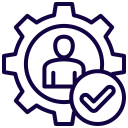Course Overview
Introduction:
Our ISO 27701 certification training is designed to equip you with the knowledge and skills needed to manage data privacy effectively.
This course is ideal for professionals aiming to advance their careers in data privacy management and is an excellent add on to the ISO 27001 certification program.
Key Features
Content
Why World Learns Here
- Leading Ed-AI Platform: The world’s first Ed-AI platform in Governance, Risk, and Compliance.
- Up-to-Date Content: Continuously updated to reflect the latest standards and best practices.
- Effective Training Methods: Proven to improve learning outcomes significantly.
- Trusted by Professionals: Over 5000 professionals certified through World Learns Here.
Target Audience:
- Data Privacy Managers
- IT Consultants
- Compliance Officers
- Risk Managers
- Privacy Professionals
Benefits of Certification
Global Recognition: The Certified Privacy Manager certification is globally recognized, enhancing your professional credibility and opening up international career opportunities.
Skill Enhancement: Gain in-depth knowledge and skills required to manage data privacy effectively, helping your organization maintain high privacy standards.
Career Growth: Certification can lead to career advancement opportunities, higher salaries, and increased job security in the field of data privacy management.
Professional Networking: Join a community of certified professionals, share knowledge, and gain insights from industry experts through our online forums and events.
Testimonials
Adeshina Olugun
Data Privacy Manager"World Learns Here’s Certified Privacy Manager course exceeded my expectations. The hands-on approach and practical exercises prepared me well for real-world privacy management scenarios."








